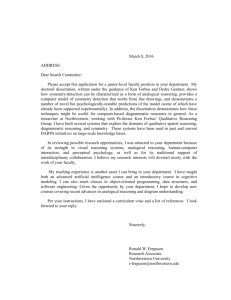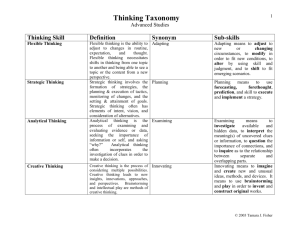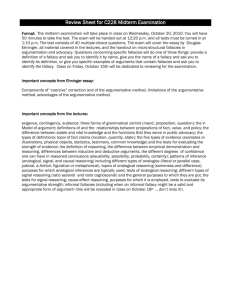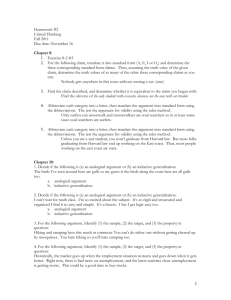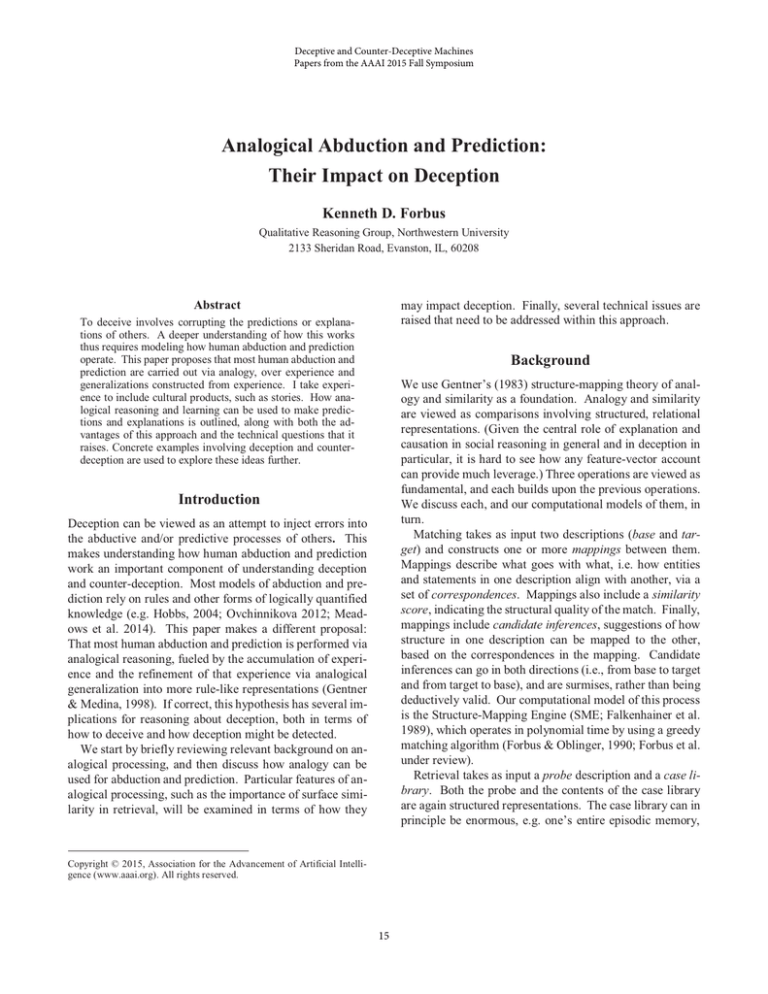
Deceptive and Counter-Deceptive Machines
Papers from the AAAI 2015 Fall Symposium
Analogical Abduction and Prediction:
Their Impact on Deception
Kenneth D. Forbus
Qualitative Reasoning Group, Northwestern University
2133 Sheridan Road, Evanston, IL, 60208
may impact deception. Finally, several technical issues are
raised that need to be addressed within this approach.
Abstract
To deceive involves corrupting the predictions or explanations of others. A deeper understanding of how this works
thus requires modeling how human abduction and prediction
operate. This paper proposes that most human abduction and
prediction are carried out via analogy, over experience and
generalizations constructed from experience. I take experience to include cultural products, such as stories. How analogical reasoning and learning can be used to make predictions and explanations is outlined, along with both the advantages of this approach and the technical questions that it
raises. Concrete examples involving deception and counterdeception are used to explore these ideas further.
Background
We use Gentner’s (1983) structure-mapping theory of analogy and similarity as a foundation. Analogy and similarity
are viewed as comparisons involving structured, relational
representations. (Given the central role of explanation and
causation in social reasoning in general and in deception in
particular, it is hard to see how any feature-vector account
can provide much leverage.) Three operations are viewed as
fundamental, and each builds upon the previous operations.
We discuss each, and our computational models of them, in
turn.
Matching takes as input two descriptions (base and target) and constructs one or more mappings between them.
Mappings describe what goes with what, i.e. how entities
and statements in one description align with another, via a
set of correspondences. Mappings also include a similarity
score, indicating the structural quality of the match. Finally,
mappings include candidate inferences, suggestions of how
structure in one description can be mapped to the other,
based on the correspondences in the mapping. Candidate
inferences can go in both directions (i.e., from base to target
and from target to base), and are surmises, rather than being
deductively valid. Our computational model of this process
is the Structure-Mapping Engine (SME; Falkenhainer et al.
1989), which operates in polynomial time by using a greedy
matching algorithm (Forbus & Oblinger, 1990; Forbus et al.
under review).
Retrieval takes as input a probe description and a case library. Both the probe and the contents of the case library
are again structured representations. The case library can in
principle be enormous, e.g. one’s entire episodic memory,
Introduction
Deception can be viewed as an attempt to inject errors into
the abductive and/or predictive processes of others. This
makes understanding how human abduction and prediction
work an important component of understanding deception
and counter-deception. Most models of abduction and prediction rely on rules and other forms of logically quantified
knowledge (e.g. Hobbs, 2004; Ovchinnikova 2012; Meadows et al. 2014). This paper makes a different proposal:
That most human abduction and prediction is performed via
analogical reasoning, fueled by the accumulation of experience and the refinement of that experience via analogical
generalization into more rule-like representations (Gentner
& Medina, 1998). If correct, this hypothesis has several implications for reasoning about deception, both in terms of
how to deceive and how deception might be detected.
We start by briefly reviewing relevant background on analogical processing, and then discuss how analogy can be
used for abduction and prediction. Particular features of analogical processing, such as the importance of surface similarity in retrieval, will be examined in terms of how they
Copyright © 2015, Association for the Advancement of Artificial Intelligence (www.aaai.org). All rights reserved.
15
via structure-mapping, because that would violate the 1:1
constraint.
These models are both compatible with existing psychological evidence and have been used to make novel predictions that have been borne out in laboratory studies. Moreover, they have been engineered to be components in performance-oriented systems, which enables larger-scale experiments than have been done with other cognitive models
of analogy. Thus they form a solid basis for exploring the
roles of analogy in abduction and prediction.
although the theory is currently agnostic on this point. However, there is ample evidence that retrieval tends to be sensitive to surface similarity, although relational information
is involved as well, and people prize structural remindings
more than surface remindings (Gentner et al. 1993). Our
computational model is MAC/FAC (Forbus et al. 1995),
which captures the dissociation between the surface and
structural properties via a two-stage process, designed for
scalability. The first stage (MAC) uses a redundant feature
vector representation for the probe and each case in the case
library that is automatically computed from the structured
representation. These content vectors are designed so that
the dot product of two of them provides an estimate of how
large a representation might be built via SME for the two
corresponding structural descriptions. The content vector
for the probe is matched against all of the content vectors for
the cases in the case library, conceptually in parallel. The
top three remindings are passed to the second stage (FAC).
FAC uses SME to compare the structured descriptions from
the case library elements returned via MAC against the
probe, with again up to three remindings being returned if
they are sufficiently close to the best.
The process of generalization involves incrementally assimilating new examples into an ongoing analogical model
consisting of generalizations and outlier examples. Our
computational model, SAGE (McLure et al. 2015) organizes
analogical models via generalization contexts, each representing a concept. For example, spatial terms such as prepositions would each be represented via a separate generalization context. Given an example of a concept, one or more
prior examples or generalizations are retrieved from the generalization context for that concept via MAC/FAC. If the
similarity score is sufficiently high, then if the retrieved item
was a generalization, the new example is assimilated into
this generalization, and if the retrieved item was an example,
then a new generalization is created by assimilating them.
The assimilation process assigns a probability to each statement in the correspondences found via SME between the
two items based on the frequency to which there is a statement that aligns in the examples that went into the generalization. For example, if 99 out of 100 swans seen were white
and one was black, the probability for the color of a swan
being white would be 0.99 and the probability for its color
being black is 0.01. Entities that are not identical are replaced with generalized entities, which have only those
properties that come from the statements in the description.
For example, if Chicago and Rome were aligned within a
generalization, a new entity would be created to replace
them in all of the facts in the generalization. While more
abstract, these new entities are still not logical variables.
They share whatever attributes held for the entities that they
came from (e.g. being a city, in this case). Moreover, two
variables can be bound to the same value via unification,
whereas two entities cannot be mapped to the same value
Abduction and Prediction
Abduction and prediction are knowledge-intensive forms of
reasoning. But what kinds of knowledge? The most common answer is some form of first-principles knowledge, i.e.
logically quantified statements that can be instantiated on a
wide range of situations. These can take multiple forms, e.g.
forward chaining rules are commonly used for predictions,
while backward chaining rules are commonly used for abduction. Special forms of such statements are often proposed to facilitate particular kinds of reasoning, e.g. causal
laws (Strasser & Aldo, 2015) for reasoning about actions, or
model fragments (Falkenhainer & Forbus, 1991) for reasoning about continuous phenomena. Such representations, by
themselves, have two key problems:
1. Combinatorial explosions. The number of abductive proofs can skyrocket if the set of predicates
that can be assumed is not tightly controlled. Similarly, forward chaining over even qualitative states
is exponential in most domains. Tactics like beam
search can help, but the fine-grained nature of such
reasoning makes for a daunting challenge.
2. Logically quantified models are better at capturing
what is possible than what is typical. For example,
it is logically possible for flipped coins to land on
their edges and for all of the air molecules in a
room to suddenly rush to a corner, leaving its occupants gasping for breath. But neither of these are
contingencies that we think of when flipping a coin
nor walking into a room.
Another kind of knowledge, missing from such accounts,
is what might be deemed experiential knowledge. Various
attempts have been made to model this via extra layers that
add probabilities (qualitative or quantitative) to logical
statements. But that begs the question of where such probabilities come from.
People have vast amounts of experience, gleaned by interacting with the world and with their culture. Since our
concern here is social reasoning and deception, we focus on
cultural experience. (Hamsters and house cats sense, act,
and learn from the physical world, and some birds make
tools, but we are the only creatures that build schools.) By
16
carve up experiences (personal or from cultural narratives)
into causal triple cases that include causally connected
statements, e.g.
(cause <ante > <conse>)
<description of <ante>>
<description of <conse>>
where <ante>, <conse> are situations or events, represented via explicit tokens in the ontology (e.g. situations can
include qualitative states, configurations holding for some
piece of space-time – I do not mean situation calculus here,
but the Cyc ontology meaning of situation). Such cases
would be stored twice, once in a generalization context for
explanations and once in a generalization context for predictions. That is, when storing in the context for explanations,
MAC/FAC would be given a requirement that a match be
found for <conse>. This provides relative frequency information as to possible causes for <conse>. Similarly, when
a new case is added to the context for predictions,
MAC/FAC would be required to provide a match for
<ante> in any retrieval, thereby constructing generalizations which provide relative frequency estimates for possible consequences of <ante>. Figure 1 illustrates, where Cg
is a generalization of <conse>s and Ag is a generalization
of <ante>s.
cultural experience I include conversations with other people and assimilating information about what people can do
from cultural products (e.g. reading books and newspapers
or watching TV and movies). While some statements in
these products are generic, interpretable as logically quantified statements, most of them are about particulars. And this
is where analogy comes in.
As Falkenhainer (1990) pointed out, the candidate inferences produced by a mapping can be deductive or abductive.
If the candidate inference consists of an instantiation of a
logically valid axiom and the mapping completely pins
down the statements in it, then the inference provides a deduction. For example,
Base: (HouseCat Nero)
(implies (HouseCat Nero)
(huntsMice Nero))
Target: (HouseCat Archie)
Mapping: Nero ↔ Archie
(HouseCat Nero) ↔ (HouseCat Archie)
Assuming that all house cats hunt mice, then one may deductively conclude that Archie, too, hunts mice. On the
other hand, if we know only
Target: (huntsMice Archie)
0.7
with the same correspondences, the best we can do is infer
that one possible reason why Archie hunts mice is that
Archie is a house cat. Archie could be a terrier or an exterminator just as easily, knowing this little about the situation.
This means that we can use analogy both as a means of deduction and abduction. What is interesting about this mechanism is that, if one of the cases has a rich, elaborate explanation, the process of applying that explanation is handled
by the matching process, all at once. It is like walking
through a space of inferences in seven-league boots, rather
than on tip-toes. This potentially makes analogical inference more efficient.
Importantly, analogical inference can still be used when
the candidate inference is not a logically correct axiom. The
qualification problem is well-known, i.e. there are an indefinite number of preconditions that might need to hold for an
action to have its intended outcome. The results must be
taken as surmises, but there are some heuristics which can
be used to help evaluate them. For example, if the two examples are very similar, e.g. house cat to house cat, or even
house cat to puma, then the inference is more likely to hold.
Similarly, if the two examples are very different, e.g. house
cat and dolphin, the inference is less likely to hold (Heit &
Rubenstein, 1994).
How can we arrange memories so that the analogical generalizations produced are useful for abduction and prediction? A promising candidate organization scheme is to
0.4
Cg
0.3
Explanations
Ag
0.5
0.1
Predictions
Figure 1: How generalization contexts might be used for facilitating analogical abduction and prediction.
I think this account is a promising start as a model for
analogy’s role in human abduction and prediction. We constantly see behaviors unfolding, and hear (or construct) explanations for why they occur. Those specific explanations
can be done much more straightforwardly than postulating
logically quantified rules that will work in all potential situations. If the conclusions are about a reason for something,
or an event that happened in the past, we can consider it to
be an abductive inference. If the conclusions are about
something that might happen in the future, we can use that
as a prediction.
This account has several implications for deception and
counter-deception. First, I assume that people track occurrences of deception, since it is useful to understand when
particular actors, categories of actors (e.g. telemarketers),
17
“Fred was angry because his phone was stolen.”
Figure 2 shows a translation of this into predicate calculus.
Now suppose we are given the first sentence of another
story:
“George was furious.”
Comparing the representation for this sentence with the
prior sentence, SME produces the following candidate inferences:
and situations (e.g. playing poker, political campaigns) are
likely to involve deception. There are multiple ways that
this could be accomplished in this framework. The simplest
is to mark some relationships in the stored cases as lies, so
that they will be retrieved as such, and probabilities as to
whether someone is lying could come out of the matching
process. When an explanation as to the reason for lying is
available, including that as well as a causal connection for
the lie would help in providing evidence for future cases
where deception might be at work. In addition to lying,
tracking someone’s accuracy is also useful, as well as properties such as whether they tend to check their sources.
Modeling these epistemic properties of someone’s social interactions could also be facilitated via the frequency information kept in analogical generalizations.
From the standpoint of planning deception, this account
provides some computational rationale for several wellknown heuristics for deception:
(victim (skolem steal25) George7)
(causes-PropProp
(eventOccurs (skolem steal25))
(feelsEmotion George7 (HighAmountFn Anger))
That is, the reason why George is furious might be that he
too was the victim of a stealing event. The term (skolem
steal25) is an analogy skolem, a new individual whose
existence is hypothesized because of the projected relational
structure. If one tentatively accepts the existence of this
event, and extends the mapping with the requirement that
the new event in the target map to steal25, then another
skolem will be introduced, in this case (skolem
phone56), to represent the item that was stolen. This gives
us another expectation, that something like a phone was stolen from him.
One of the tasks in analogical reasoning and learning is
resolving such skolems. There are several techniques that
have been used, including postulating a new category of individual in the domain theory (Falkenhainer, 1990), projecting the base domain individual into the target (e.g. Klenk &
Forbus, 2009, good for within-domain analogies), and using
a constraint solver over the union of constraints implied by
the mapping (e.g. Forbus et al. 2003, good for spatial entities). Context often provides answers: If the next sentence
were
“His laptop was gone.”
then we could conjecture that the thing like the cell phone is
the laptop. Moreover, if we know that something being
gone is one of the consequences of it being stolen, we can
project the act of stealing, which provides a possible explanation of why the laptop is gone.
Let us consider how a clever thief might use their experience to change their modus operandi to reduce their likelihood of being caught. A victim who doesn’t notice a theft
can’t report it. How might they detect the theft of a laptop?
There are several possible ways: They might find their bag
lighter than it would be otherwise, or squish flatter than it
normally does. They might try to get it out, in order to use
it. All of these possibilities could be predicted based on experience, as anyone who has noticed a missing device, for
whatever reason, knows. Removing the detectable differences would change the world sufficiently that the causal
antecedents (as encoded in the mapped relational structure)
would be incorrect and thus the prediction would not hold.
•
Use excuses that will be highly salient to the victim. Since the evaluation of the plausibility of the
deceptive alternative will involve analogical retrieval, picking highly salient experiences for the
victim means the deception is more likely to resonate and be undetected.
• Avoid excuses that have become stereotyped. A
soon to be obsolete classic is “The dog ate my
homework”, for instance. Once an excuse can be
mapped to such a stereotype (“the printer ate my
homework”), it starts being associated with being
an excuse rather than a reason.
• Use excuses that are hard to check. If the kind of
information that it would take to invalidate it is
hard to obtain, as estimated by causal triple cases
pertaining to information-gathering, it is a better
excuse.
Some examples of this are considered in the next section.
Figure 2: Formal representation using Cyc ontology.
Some Examples
Considering the following very simple story:
18
Going to an extreme, replacing the victim’s laptop with a
functioning machine of the exact same make and model
would minimize the differences and thus delay detection the
most. (Such reasoning, I assume, is based on comparative
analysis via qualitative models (Weld, 1990), rather than
having, say, numerical probabilities for detection as a function of quantitative differences.) Unless the thief’s goal is
the information on the laptop rather than the physical device
itself, this is an extreme expense and probably not worth it.
Replacing it with something roughly similar: A glossy magazine, in the case of modern lightweight machines, or a
phone book, for a turn-of-the-century model, might increase
risk of earlier detection but would be a lot more profitable.
How might that tradeoff be evaluated? If you keep track of
how often your fellow laptop thieves are arrested and what
their preferred techniques are, you can build up (again via
analogical generalization) an estimate of the likelihood of
being caught for various techniques.
4.
Open Questions
The account presented here raises a number of open questions. The four most obvious are:
1. Granularity of memory. Using a single generalization
context for all explanations and predictions may or
may not scale. On the other hand, there are reasons
to build up analogical models (via generalization) of
categories of events and/or situations independent of
prediction and explanation, such as being able to recognize them. We have explored automatic introduction of hierarchal generalization contexts, to model
human conceptual structure more closely (Liang &
Forbus, 2014), so that may be a better way to proceed. However, current hierarchical clustering methods are batch-oriented, which is not psychologically
plausible. Moreover, while events often correspond
to verbs and thus are very well ontologized, situations are less so.
2. Skolem resolution strategies. Even within-domain
analogies can involve more sophisticated strategies
for resolving skolems than simply projecting the base
entity. If the next sentence in the George example
had been “He lost his laptop.” then most readers
would align a LosingSomething event with the Stealing-Physical event. This could involve either estimating the similarity of the two types of events to see
if they are plausibly aligned, or decomposing them to
see if the specific ways in which they are alike could
explain what happened (i.e. they both involve loss of
control over a piece of property).
3. Estimation of probabilities for candidate inferences.
As noted above, SAGE constructs probabilities for
every statement in a generalization. The probabilities are frequency information, i.e. how often does a
statement in the cases that make up the generalization
align with that statement in the generalization. It is
straightforward to convert such probabilities into estimations of various explanations or predictions, by
making a closed-world assumption over the set of
causal transitions. However, it is less obvious how
to combine those probabilities with the similarity of
a retrieved generalization to the current situation to
estimate the likelihood of particular predictions or
explanations.
Qualitative probabilities in cultural products. Cultural products can provide a skewed view of human
life: In IBM’s PRISMATIC knowledge base, for example, “the most common actions that Pat Garrett
was involved in are kill, shot, and capture; and the
most common object of these actions is Billy the
Kid.” (Fan et al. 2012, p 5:1). That Pat Garrett far
more frequently breathed, ate, and slept are simply
not mentioned in stories, because they are uninteresting even while being vital to know, at least tacitly.
The idea of tracking all of the mundane aspects of
everyday life in order to estimate accurate probabilities of them seems unlikely. Instead, once we establish something as normal, frequent, and typical, we
may stop accumulating information and simply mark
them in some way that is recognized when combining information as being a normal default. Understanding these representations and how they are used
is an interesting challenge.
Other Related Work
Clark (Clark, 2011) has investigated building systems
whose lies are more plausible because they coincide with
well-known cognitive illusions in human reasoning. It
would be interesting to see under what conditions these
same illusions occur under analogical reasoning.
Bello & Guarini (2010) explore some of the representational and reasoning capabilities of mental simulation required for mindreading, an essential operation in deception.
They treat the problem as a first-principles reasoning task,
using Polyscheme’s inheritance plus overrides mechanism.
This paper has not addressed mind-reading, however it is
interesting to note that analogical reasoning has been proposed as a means of performing the mental simulation involved in learning about others (e.g. Meltzoff 2007). This
seems like a potentially useful approach to explore.
Heuristics appear to play a major role in human reasoning
(Tversky & Kahneman, 1974; Gigerenzer, Todd, & ABC
group, 1999). There seem to be useful connections between
19
Forbus, K. and Gentner, D. (1997). Qualitative mental models:
Simulations or memories? Proceedings of the Eleventh International Workshop on Qualitative Reasoning, Cortona, Italy, June 36, pp. 97-104.
Forbus, K. D., Klenk, M., & Hinrichs, T. (2009). Companion cognitive systems: Design goals and lessons learned so far. IEEE Intelligent systems, 24(4), 36-46.
Forbus, K.D. & Oblinger, D. (1990). Making SME greedy and
pragmatic. Proceedings of the Twelfth Annual Conference of the
Cognitive Science Society. Hillsdale: Erlbaum.
Forbus, K., Usher, J., & Chapman, V. (2003). Qualitative Spatial
Reasoning about Sketch Maps. Proceedings of the Intelligence
User Interfaces Conference, 2003, January: Miami, Florida.
Forbus, K., Ferguson, R., Lovett, A., & Gentner, D. (under review).
Extending SME to Handle Large-Scale Cognitive Modeling.
Gentner, D., 1983. Structure-mapping: A theoretical framework
for analogy. Cognitive Science 7(2), 155-170.
Gentner, D., & Medina, J. (1998). Similarity and the development
of rules. Cognition, 65, 263-297.
Gentner, D., Rattermann, M.J., & Forbus, K.D. (1993). The roles
of similarity in transfer: Separating retrievability from inferential
soundness. Cognitive Psychology 25, 524-575.
Gigerenzer, G., Todd, P. & the ABC Group (1999). Simple Heuristics That Make Us Smart. Oxford University Press.
Heit, E., & Rubinstein, J. (1994). Similarity and property effects
in inductive reasoning. Journal of Experimental Psychology:
Learning, Memory, and Cognition, 20, 411-422.
Hobbs, J.R. 2004. Abduction in Natural Language Understanding.
In Horn, L. and Ward, G. (eds.), Handbook of Pragmatics, pp. 724741, Blackwell.
Klenk, M. and Forbus, K. (2009). Analogical Model Formulation
for AP Physics Problems. Artificial Intelligence, 173(18), 16151638.
Liang, C. and Forbus, K. (2014). Constructing Hierarchical Concepts via Analogical Generalization. Proceedings of the Cognitive
Science Society.
McLure, M.D., Friedman S.E. and Forbus, K.D. (2015). Extending
Analogical Generalization with Near-Misses. Proceedings of the
Twenty-Ninth AAAI Conference on Artificial Intelligence, Austin,
Texas.
Meadows, B., Langley, P., & Emery, M. (2014). An Abductive Approach to Understanding Social Interactions. Advances in Cognitive Systems 3, pp 87-106.
Meltzoff, A. (2007) The “like me” framework for recognizing and
becoming an intentional agent. Acta Psychologica, 124(1), pp. 2643.
Strasser, Christian and Antonelli, G. Aldo, Non-monotonic Logic.
The Stanford Encyclopedia of Philosophy (Fall 2015 Edition), Edward N. Zalta (ed.).
Tversky, A., & Kahneman, D. (1974). Judgment under Uncertainty: Heuristics and Biases. Science, 185(4157), pp. 1124-1131.
Ovchinnikova, E. (2012) Integration of World Knowledge for Natural Language Understanding, Atlantis Press, Springer
Weld, D. (1990). Theories of Comparative Analysis. MIT Press.
these ideas and analogical reasoning in two directions. Analogical retrieval seems a useful candidate for modeling
some of the accessibility-based heuristics, and heuristics
might be usefully employed in skolem resolution.
Conclusions
Humans are creatures with limited capabilities and resources, operating with incomplete and uncertain information in complex environments. Shortcuts are always necessary. Analogical reasoning and learning over experience
potentially provides a basis for rapidly reasoning and learning, without requiring complete or correct domain theories.
To the extent that people are indeed using analogy heavily
in everyday reasoning, those wishing to deceive, or to counter deception, should be aware of its psychological properties. This paper has provided an initial step in that direction.
Beyond this initial step, there are two things that need to
be done. The first is further theoretical analyses, to better
understand the issues involved in using analogical reasoning
and learning at scale. The second are experimental investigations: What will it take to create systems that achieve human-like analogical reasoning at scale? This provides several daunting challenges, including creating systems by
which such experiences can be automatically encoded with
minimal human labor, both to reduce tailorability and for
practicality.
Acknowledgements
I thank Tom Hinrichs, David Barbella, and Joe Blass for
helpful suggestions. This research was supported by the
Cognitive Science Program of the Office of Naval Research.
References
Bello, P. & Guarini, M. (2010). Introspection and Mindreading as
Mental Simulation. In Proceedings of the 32nd Annual Meeting of
the Cognitive Science Society.
Clark, M., (2011). Mendacity and Deception: Uses and Abuses of
Common Ground. In AAAI Fall Symposium on Building Representations of Common Ground with Intelligent Agents.
Falkenhainer, B. (1990). A unified approach to explanation and
theory formation. In Shrager, J. & Langley, P. (Eds.), Computational Models of Scientific Discovery and Theory Formation. San
Mateo, CA: Morgan Kaufmann.
Falkenhainer, B., Forbus, K.D., & Gentner, D. (1989). The Structure-Mapping Engine: Algorithm and Examples. Artificial Intelligence, 41, 1-63.
Fan, J., Kalyanpur, A., Gondek, D., & Ferrucci, D. (2012). Automatic knowledge extraction from documents. IBM Journal of Research and Development, 56(3/4), pp 5:1-5:10.
Forbus, K., Gentner, D., & Law, K. (1995). MAC/FAC: A model
of similarity-based retrieval. Cognitive Science, 19, 141-205.
20

